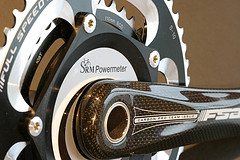SRM and PowerTap Are Not Allowed in the Pro Tour 2009
APRIL FOOL: UCI has declared that power meters like SRM, PowerTap etc. will not be allowed in the Pro Tour next year. There also a couple of other implementations for next years’ Pro Tour that may surprise some of you. I will give you a short summary of the press release:
Why Power meters are no longer allowed:
Ӣ There are significant better results from riders using power meters which indicate that they have a huge advantage during the races than other riders. UCI wants to make everybody equal (at least their equipment status) to make a fair competition.
Ӣ UCI has chosen to avoid dictation of how riders should ride from e.g. power meters or radio communication. These steps should make riders using their instincts instead of just acting like a machine. UCI has already disallowed radio communication in the U23 Nations Cup this year and implements the same rule in the Pro Tour 2009.
The press release also indicates that 2009 may very likely be the last season with heart rate monitors, carbon wheels and disc wheels. Service cars leave the peloton from 2011 which should be time enough for riders to learn what to do when they have a flat tire. Seems like it is going to be old school cycling in the future…!
My comment:
I think this decision is a huge step backwards for pro cycling. Power meters have shown their relevancy in broad range of situations and made training even more sophisticated. UCI can’t disallow power meters in training situations which means that riders using power meters will still have a great advantage. UCI is obviously not aware that the biggest advantage of power meters are in training rides and post-race-analyses. During the races the bonus from having a power meter mounted is minimal (except time trials). But having data files from the races is a really helpful thing for analysis of performance.
I have started collection of names on people who dislike the mistake of UCI:
Support my campaign: Legalize SRM and PowerTap
If you want to support my campaign, please write your name here. I will send the full list of names to the President of UCI. 10408 riders have already shown their support in this way.
What do you think? Should power meters be disallowed next year?
SRM and PowerTap Are Not Allowed in the Pro Tour 2009 Read More »

